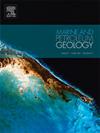Pioneering data on detection, identification and quantification of key carbonate minerals using spectral tomography
IF 3.6
2区 地球科学
Q1 GEOSCIENCES, MULTIDISCIPLINARY
引用次数: 0
Abstract
In this study, we present, for the first time, the spectral computed tomography (sp-CT) signatures of key carbonate rock-forming minerals namely, calcite, magnesian calcite, dolomite, and magnesite. Although the raw spectra of these phases may not be readily distinguishable, we demonstrate that they appear in clusters on a multi-energy histogram derived from laboratory sp-CT. These clusters show a strong correlation with the MgCO3 mol.% of the carbonate phases. In addition to discriminating among these carbonate phases, we demonstrate the capability of time-resolved sp-CT to monitor mineral replacement reactions in carbonates. As an example, we analyze a series of time-lapse sp-CT images of a carbonate sample undergoing hydrothermal dolomitization in the laboratory. The results reveal a progressive transformation of pure calcite into an Mg-rich carbonate, with the sp-CT data indicating a final composition of approximately 32 mol.% MgCO3. This estimate, while lower than the 46–50 mol.% MgCO3 determined through complementary chemical analysis, provides a valuable first-order approximation. This contribution introduces a novel methodology for visualizing, monitoring, and quantifying such chemical reactions in multi-phase carbonate systems, in 2D, 3D and even 4D, offering advantages over destructive techniques such as 3D FIB-tomography. Our findings pave the way to further exploration of carbonate diagenesis and open up new perspectives for the application of spectral tomography in Earth sciences.
利用光谱层析成像技术对关键碳酸盐矿物进行探测、鉴定和定量的开创性数据
在这项研究中,我们首次提出了关键碳酸盐岩形成矿物方解石、镁质方解石、白云石和菱镁矿的光谱计算机断层扫描(sp-CT)特征。虽然这些相的原始光谱可能不容易区分,但我们证明它们出现在实验室sp-CT衍生的多能直方图上。这些团簇与碳酸盐相的MgCO3摩尔%有很强的相关性。除了区分这些碳酸盐相外,我们还展示了时间分辨sp-CT监测碳酸盐中矿物替代反应的能力。作为一个例子,我们分析了一系列在实验室中经历热液白云化的碳酸盐样品的延时sp-CT图像。结果显示,纯方解石逐渐转变为富镁碳酸盐,sp-CT数据表明,最终成分约为32mol .% MgCO3。这一估计虽然低于通过补充化学分析确定的46-50 mol.% MgCO3,但提供了有价值的一阶近似。这一贡献介绍了一种新的方法,用于在2D、3D甚至4D多相碳酸盐系统中可视化、监测和定量此类化学反应,具有优于3D fib断层扫描等破坏性技术的优势。这些发现为进一步探索碳酸盐岩成岩作用铺平了道路,为光谱层析成像在地球科学中的应用开辟了新的前景。
本文章由计算机程序翻译,如有差异,请以英文原文为准。
求助全文
约1分钟内获得全文
求助全文
来源期刊

Marine and Petroleum Geology
地学-地球科学综合
CiteScore
8.80
自引率
14.30%
发文量
475
审稿时长
63 days
期刊介绍:
Marine and Petroleum Geology is the pre-eminent international forum for the exchange of multidisciplinary concepts, interpretations and techniques for all concerned with marine and petroleum geology in industry, government and academia. Rapid bimonthly publication allows early communications of papers or short communications to the geoscience community.
Marine and Petroleum Geology is essential reading for geologists, geophysicists and explorationists in industry, government and academia working in the following areas: marine geology; basin analysis and evaluation; organic geochemistry; reserve/resource estimation; seismic stratigraphy; thermal models of basic evolution; sedimentary geology; continental margins; geophysical interpretation; structural geology/tectonics; formation evaluation techniques; well logging.
 求助内容:
求助内容: 应助结果提醒方式:
应助结果提醒方式:


